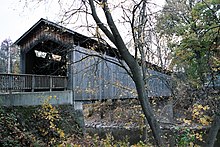Ada Covered Bridge
| Ada Covered Bridge | |
|---|---|

Upstream view from observation deck in park.
|
|
| Coordinates | 42°57′09″N 85°29′11″W / 42.952477°N 85.486325°WCoordinates: 42°57′09″N 85°29′11″W / 42.952477°N 85.486325°W |
| Carries | Fase/Bronson St. (footpath) |
| Crosses | Thornapple River |
| Locale | Ada, Michigan |
| Maintained by | Kent County Road Commission |
| Characteristics | |
| Design | Brown truss Covered bridge |
| Total length | 125 ft |
| Width | one lane |
| Longest span | 125 ft |
| History | |
| Opened | 1867 |
| Closed | still open, foot traffic only |
| Statistics | |
| Toll | no |

TIGER image, Red dot marks bridge
|
|
The Ada Covered Bridge is a 125-foot (38 m) span Brown truss covered bridge erected in 1867 in Ada, Michigan, United States. Carrying Bronson Street across the Thornapple River, it is located just south of where the Thornapple enters the Grand River, in turn just south of M-21. It is listed on the National Register of Historic Places.
The bridge uses the Brown truss system, consisting of diagonal compression beams and almost vertical tension members (slanting in at the top toward the center of the span) was patented by Josiah Brown of Buffalo, New York in 1857. A timber bearing Brown's name was discovered during repair work carried out in 1913.
The bridge is 125 feet (38 m) long, and originally rested on wooden pilings. As is typical for covered bridges, its gabled roof is covered with creosote shingles.
The Michigan State Legislature authorised Ada Township to borrow up to $3,000 for building or maintaining bridges in the area. Construction of this bridge, also known as the "Bradfield Bridge" was carried out in 1867 by William Holmes.
Prior to construction of the upstream dam, the Thornapple River was prone to flooding. According to a historical marker posted at the bridge, "it is said that farmers used to drive wagons loaded with stones onto the bridge during high water to hold it to the foundation."
Repair work was carried out in 1913 to modify the trusses, and replace the timber abutments with reinforced concrete. The bridge was part of an important artery into the village of Ada until 1930, when the main highway was rerouted and a concrete bridge built further down the Thornapple River. At that time the bridge was closed to automobile traffic, reverting to pedestrian use only.
In 1941 the Kent County Road Commission and the Works Progress Administration made extensive restorations, re-roofing the bridge with new protective creosote shingles and replacing many of its decayed underlying supports with new beams. The Road Commission purchased a nearby barn to supply wood for replacement of badly deteriorated elements.
...
Wikipedia
